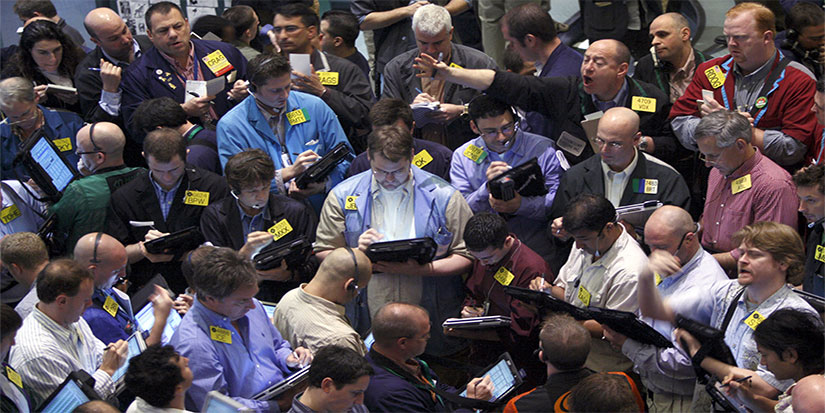
You Can’t Stop Progress
-
 Jared Dillian
Jared Dillian
- |
- October 20, 2022
- |
- Comments
I started my career on the Pacific Options Exchange in San Francisco. I got a job there because one of the market makers tried to throw a water bottle in the trash and almost hit me in the head. The stock clerk standing next to me asked if I was looking for a job. Then he took me over to a guy who ran a market-making firm. I aced the interview and got hired. Things were simpler back then.
I was a clerk. It was an apprenticeship job—my role was to get coffee and breakfast for people, take their trade tickets and enter them into MicroHedge, and print out risk reports and bring them back. When I wasn’t doing that, my job was to absorb as much information as I possibly could because, one day, I could be a market maker. That wasn’t my ambition, but I made good use of my time—I spent most of my days standing in the back of the pit, watching.
The business model of my market-making firm was as follows: buy on your bid, sell on your offer, hedge the stock, and capture theoretical edge. Pretty simple if you didn’t try to grow a brain. There was a lot of edge in those markets back then—on average, options on big, liquid stocks were half a buck wide… and sometimes larger. This was pre-decimalization, so options traded in fractions—teenies and eighths—instead of decimals. My first day at work was actually on the day that dual listings were first allowed—prior to that, an exchange had a monopoly on the options that traded there. From that point forward, the Chicago Board Options Exchange (CBOE), the American Stock Exchange (AMEX), and the Philadelphia Stock Exchange PHLX could all list options on Microsoft, in competition with the P. Coast, as it was known. After that, bid-offer spreads began to compress fairly rapidly.
And then, in my second year on the floor, the International Securities Exchange opened—the first all-electronic options exchange. That was the beginning of the end. By about 2003, the trading floor had been mostly cleaned out—it was too hard to make money. But while I was there, it was a food fight.
|
[Peek Inside John Mauldin’s Rolodex] John Mauldin’s circle of connections allows him special access to quality research from some of the top macroeconomists, political strategists, former Fed governors, and other top-level financial minds. Find out how you can look over his shoulder to gain access to the best of this research for yourself. |
Finance’s Spotted History
There was a lot of underground stuff that was going on there. A lot of drugs. A lot of drug dealing right on the floor. People used to go out and party and stay out all night, then roll onto the floor around 5 am the next morning, looking like the walking dead. I was in the military at the time, so I disapproved of this behavior. I wasn’t going to be one of these sybaritic monkeys. That was finance back then—in its ugliest, most exciting time. Just a complete free-for-all. There were a number of people who were claimed by the lifestyle, not the profit and loss.
The other exchange floors were the same way. I spent some time on the CME when I was trading index arbitrage, and you had the usual drugs and underground stuff, but also various factions of organized crime. There were threats of violence and actual violence. You could make a small (or large) fortune trading futures in those pits, but you were taking your life into your own hands. There were some very unsavory characters.
Of course, all of that is now gone—computers have replaced the floor market makers. We don’t seem to be any happier with this system. We were in a big hurry to have electronic markets after the New York Stock Exchange (NYSE) specialist scandal, but people haven’t been excited about the computers, either. We think that the computers are stealing from us. Not really, but if you plug a simple volume-weighted average price order into an algorithm, the high-frequency traders are going to figure out that you have stock to buy and buy it ahead of you. This isn’t illegal because they aren’t in possession of knowledge of an order; they simply sleuthed it. The computers aren’t crooks, but the people programming them can be. In any case, there is no putting the toothpaste back in the tube. Open outcry trading is gone for good. If we ever opened up an exchange floor somewhere, I can tell you that I would quit the newsletter in a nanosecond, and I would be standing on the floor with a bunch of crumpled-up risk sheets and half a chicken parm sandwich.
There were some very unsophisticated people on that trading floor. People who probably had no business trading options. But they were there, making boatloads of money. It was that easy. That was the last time in history that trading has ever been easy. Now, it is the realm of MSFs and PhDs. People who program in Python. People who read a lot of Neal Stephenson. There was a point in time when a live person handled every order you sent. There really is only one exchange floor running these days: the NYSE. And it is a wax museum, there for selfies only. You can’t stop progress, I guess.

Jared Dillian
subscribers@mauldineconomics.com

 Jared Dillian
Jared Dillian